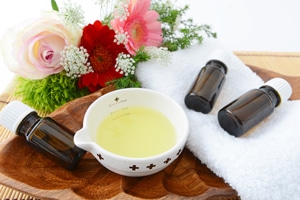March 13, 2017
Therapeutic Essential Oils: More Than A Nice Fragrance
By Michael D. Shaw
The term “essential oil” may sound odd to our modern ears, since the usual meaning of “essential” refers to a particular item being necessary or indispensable. In this case, however, essential oils are complex mixtures of volatile organic compounds isolated from odoriferous plants. They are deemed such owing to historical perceptions that they impart the very essence of odor and flavor to the plant in question.
The oils are mentioned in writings from ancient India, Persia, and Egypt, with both Greece and Rome engaging in widespread trade for the substances. The advent of distillation in the Middle Ages improved both the quality and availability of the oils. From the outset, essential oils have been recognized for their medicinal value, as well as being used in perfumes and as food/beverage flavoring agents.
Certain essential oils derived primarily from pine trees (such as turpentine and pine oil) comprise a part of what is known as “naval stores,” originally used to maintain wooden sailing ships.
While the benefits of essential oils to humans are recognized, authorities speculate on how they might be helping the plants themselves. The fragrance of flowers probably attracts insects; leaf oils, wood oils, and root oils are likely protective. Few essential oils seem to be directly involved in plant metabolism, leading some observers to conclude that they are merely waste products of the plant’s biosynthesis.
Experts have identified around 3,000 essential oils, out of which approximately 300 are commercially important and are traded in the world market. No recognized certification exists for “therapeutic grade” essential oils, but the most common ones used for therapeutic purposes include: Castor, chamomile, eucalyptus, frankincense, geranium, jasmine, lavender, lemon, neem, orange, peppermint, rose, rosemary, sandalwood, sweet almond, and tea tree oil.
Unlike many natural products touted for health benefits, essential oils have an extensive scientific literature, with more than 16,000 papers indexed in PubMed. Sundry websites detail the therapeutic properties of essential oils, but here are a few, all of which have numerous literature citations…
- Chamomile—anti-inflammatory, anti-allergic, anti-pruritic, and antispasmodic
- Eucalyptus—anti-catarrhal, expectorant and mucolytic, antimicrobial, antiviral
- Lavender—antispasmodic, sedative, relaxing, analgesic, anti-inflammatory, antimicrobial
- Tea tree oil—antimicrobial, antiviral, antiasthenic, neurotonic, decongestant, radioprotective, antispasmodic
Those interested in therapeutic essential oils are advised to study product labels, paying special attention to the purity, and checking for a recognized organic certification, such as that offered by the USDA. One company that prides itself on product purity, its USDA organic certification, and even kosher certification in many cases is Mary Tylor Naturals.
Founder and CEO Gonen Yohananof told me about his company’s recent partnering with online retail giants Walmart and Amazon, as well as his new line of therapeutic essential oils. Being passionate about doing right by the customer, Yohananof offers Do It Yourself Skin Care ideas, based on ingredients already in your pantry or refrigerator.
By the way, here are the essential oils mentioned in the Bible (typically there are multiple citations besides those shown):
- Aloe vera (Song of Solomon 4:14)
- Cassia [cinnamon] (Exodus 30:24)
- Cedarwood (Leviticus 14:4 )
- Frankincense (Matthew 2:11)
- Galbanum (Exodus 30:34)
- Myrrh (Song of Solomon 5:5)
- Spikenard (Mark 14:3)
Talk about your literature references!

